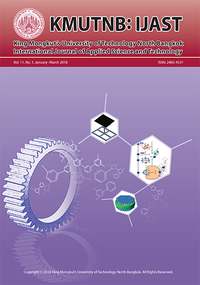Plant-wide Process Simulation of Ethanol Production from Empty Fruit Bunch
Main Article Content
Abstract
Lignocellulosic biomass exhibits itself as an alternative material for ethanol production. Ethanol can be synthesized from cellulose and hemicellulose obtained from an empty fruit bunch. Aspen simulation is used for process design and its capacity. Hot Compressed Water pretreatment (HCW) is the first step to improving ethanol production. The optimal conditions of HCW are 190°C and 15 minute with a cellulose content of 56.56%. Ethanol is converted from lignocellulosic derivative via hydrolysis and fermentation processes. The extractive distillation system is proposed to purify. There are two different operating conditions (reflux ratio, feed stage, and distillate to feed ratio) at the solvent to feed ratio (S/F) of about 0.51. Ethanol of 10,000 kg could be produced from 48,000 kg of EFB with product purity greater than 99.5 wt%.
Article Details
References
[2] M. Balat, H. Balat, and C. Oz, “Progress in bioethanol processing,” Progress in Energy and Combustion Science, vol. 34, pp. 551–573, 2008.
[3] D. Piarpuzan, J. A. Quintero, and C. A. Cardona, “Empty fruit bunches from oil palm as potential raw material for fuel ethanol production,” Biomass and Bioenergy, vol. 35, no. 64–60, pp. 1130–1137, 2011.
[4] A. Limayem and S. Ricke, “Lignocellulosic biomass for bioethanol production: Current perspectives, potential issues and future prospects,” Progress in Energy and Combustion Science, vol. 38, pp. 449–467, 2012.
[5] C. Cheng, K. Hani, and S. Ismail, “Production of bioethanol from oil palm empty fruit bunch,” in Proceedings 1st International Conference on Sustainable Materials 2007(ICoSM2007), 2007, pp. 69–72.
[6] B. Joseph and T. Ronald, “Fermentable sugars by chemical hydrolysis of biomass,” Proceedings of the National Academy of Sciences, vol. 107, pp. 4516–4521, 2010.
[7] Q. Xiang, Y. Lee, P. Pettersson, and R. Torget, “Heterogeneous aspects of acid hydrolysis of α-cellulose,” Applied Biochemistry and Biotechnology, vol. 105–108, pp. 504–514, 2003.
[8] M. Graeme and G. Graham, “Saccharomyces cerevisiae in the production of fermented beverages,” Beverages, vol. 2, pp. 1–12, 2016.
[9] D. Keelsall, K. Jcques, and T. Lyons, “Understanding yeast fundamentals,” in The Alcohol Textbook, 4th ed. Nottingham: Nottingham University Press, 2003, pp. 94–99.
[10] R. Wooley, M. Ruth, J. Sheehan, and K. Ibsen, “Lignocellulosic biomass to ethanol process design and economics utilizing co-current dilute acid prehydrolysis and enzymatic hydrolysis current and futuristic scenarios,” National Renewable Energy Laboratory, Colorado, Tech. Rep. TP-510- 32438, Jun. 2002.
[11] H. Meehnian, A. K. Jana, and M. M. Jana, “Effect of particle size, moisture content, and supplements on selective pretreatment of cotton stalks by Daedalea flavida and enzymatic saccharification,” 3 Biotech, vol. 6, pp. 235(1–13), 2016.
[12] I. D. Gil, J. M. Gómez, and G. Rodríguez, “Control of an extractive distillation process to dehydrate ethanol using glycerol as entrainer,” Computers and Chemical Engineering, vol. 39, pp.129–142, Apr. 2012.
[13] V. G. Grassi, “Process design and control of extractive distillation,” in Practical Distillation Control, New York: Van Nostand Reinhold press, 1993, pp. 370–404.
[14] W. L. Luyben, “Comparison of extractive distillation and pressure-swing distillation,” Industrial and Engineering Chemistry, vol. 47, no. 8, 2008.


